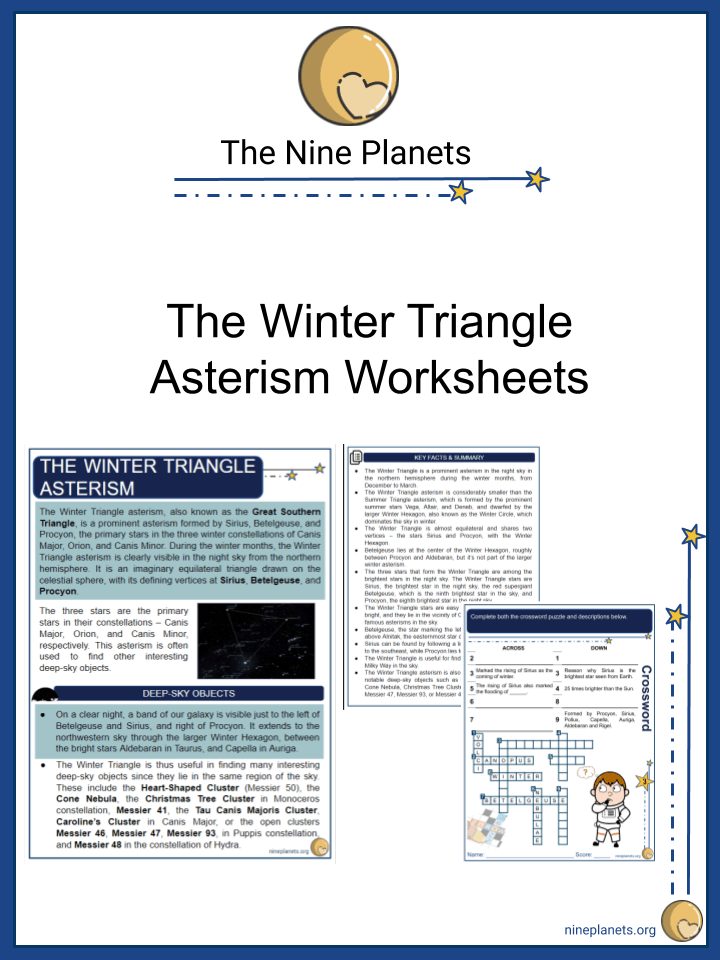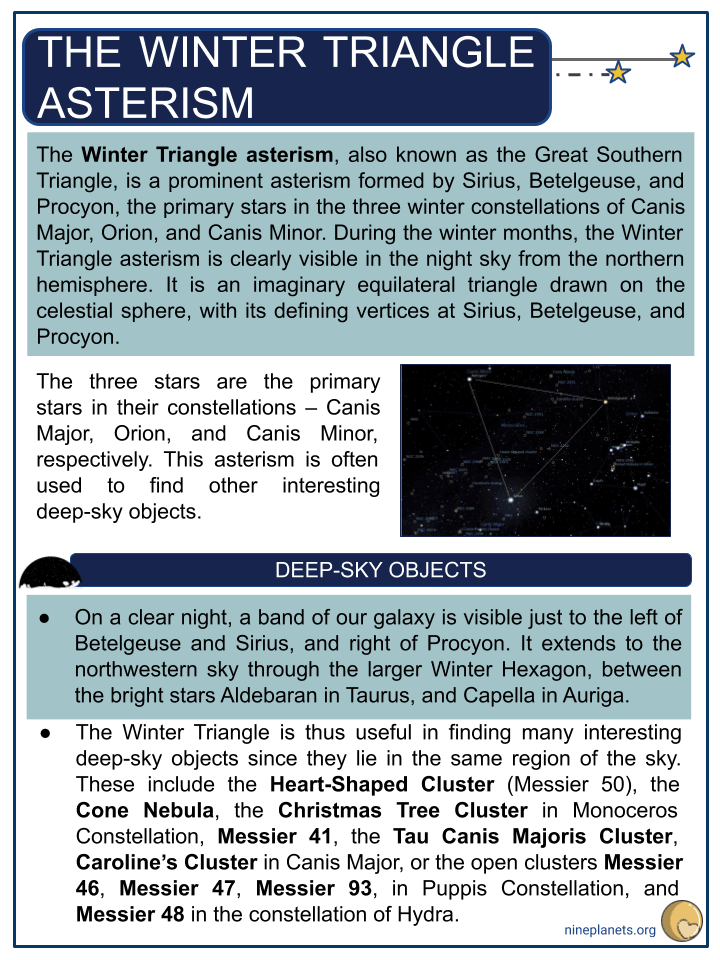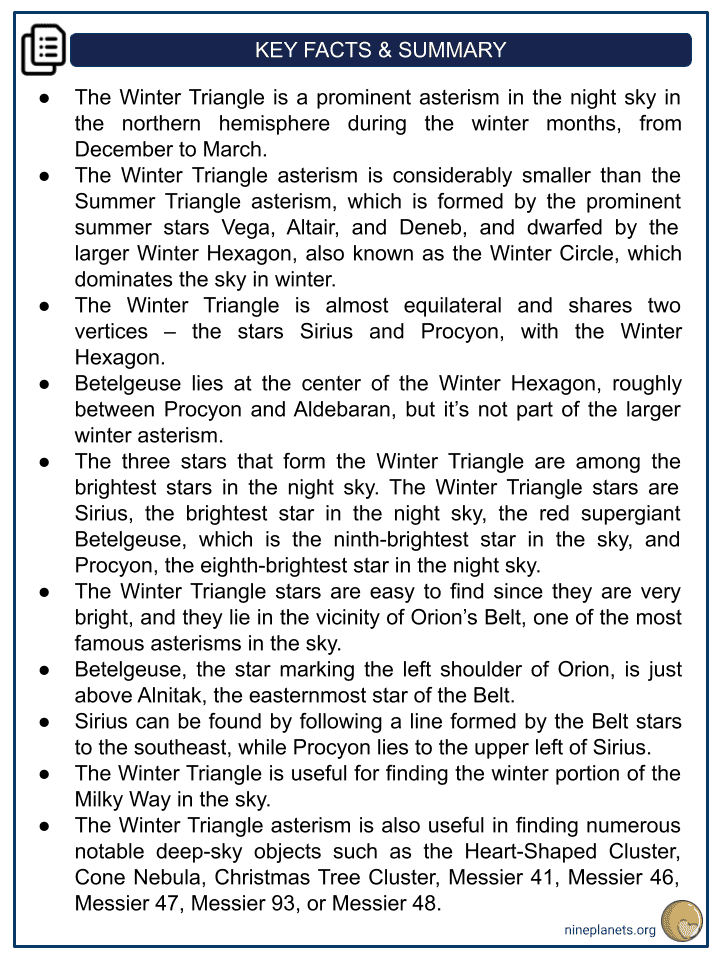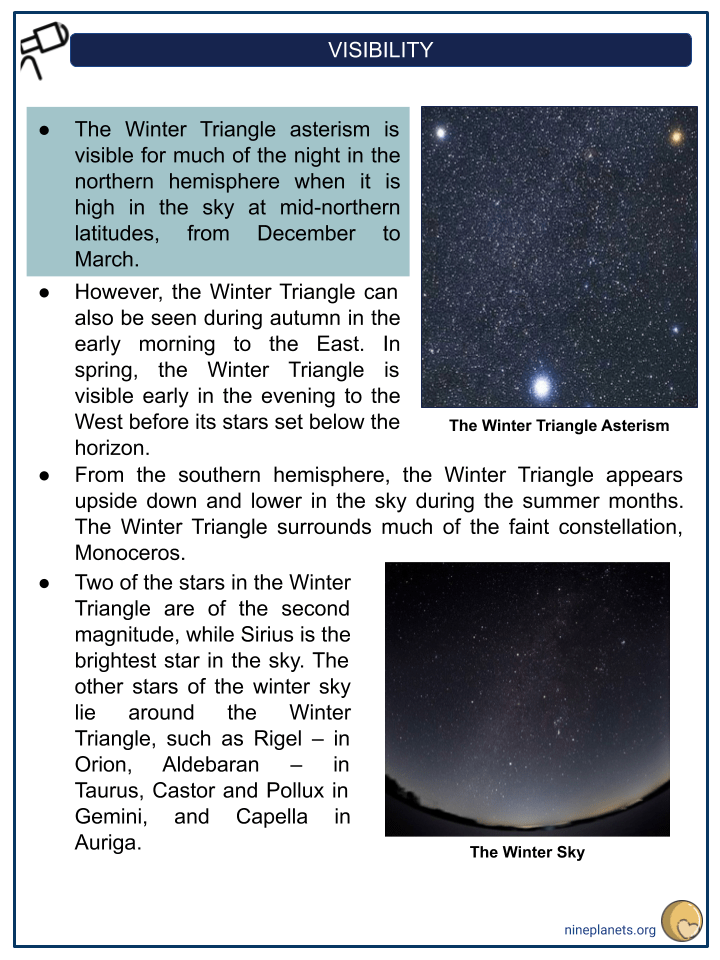Download The Winter Triangle Asterism Worksheets
Click the button below to get instant access to these premium worksheets for use in the classroom or at a home.

This worksheet can be edited by Premium members using the free Google Slides online software. Click the Edit button above to get started.
Download free sample
Not ready to purchase a subscription yet? Click here to download a FREE sample of this worksheet pack.
Resource Examples
Click any of the example images below to view a larger version.




Key Facts & Information
- The Winter Triangle asterism, also known as the Great Southern Triangle, is a prominent asterism formed by Sirius, Betelgeuse, and Procyon, the primary stars in the three winter constellations of Canis Major, Orion, and Canis Minor. During the winter months, the Winter Triangle asterism is clearly visible in the night sky from the northern hemisphere. It is an imaginary equilateral triangle drawn on the celestial sphere, with its defining vertices at Sirius, Betelgeuse, and Procyon.
- The three stars are the primary stars in their constellations – Canis Major, Orion, and Canis Minor, respectively. This asterism is often used to find other interesting deep-sky objects.
Deep-Sky Objects
- On a clear night, a band of our galaxy is visible just to the left of Betelgeuse and Sirius, and right of Procyon. It extends to the northwestern sky through the larger Winter Hexagon, between the bright stars Aldebaran in Taurus, and Capella in Auriga.
- The Winter Triangle is thus useful in finding many interesting deep-sky objects since they lie in the same region of the sky. These include the Heart-Shaped Cluster (Messier 50), the Cone Nebula, the Christmas Tree Cluster in Monoceros Constellation, Messier 41, the Tau Canis Majoris Cluster, Caroline’s Cluster in Canis Major, or the open clusters Messier 46, Messier 47, Messier 93, in Puppis Constellation, and Messier 48 in the constellation of Hydra.
Key Facts & Summary
- The Winter Triangle is a prominent asterism in the night sky in the northern hemisphere during the winter months, from December to March.
- The Winter Triangle asterism is considerably smaller than the Summer Triangle asterism, which is formed by the prominent summer stars Vega, Altair, and Deneb, and dwarfed by the larger Winter Hexagon, also known as the Winter Circle, which dominates the sky in winter.
- The Winter Triangle is almost equilateral and shares two vertices – the stars Sirius and Procyon, with the Winter Hexagon.
- Betelgeuse lies at the center of the Winter Hexagon, roughly between Procyon and Aldebaran, but it’s not part of the larger winter asterism.
- The three stars that form the Winter Triangle are among the brightest stars in the night sky. The Winter Triangle stars are Sirius, the brightest star in the night sky, the red supergiant Betelgeuse, which is the ninth-brightest star in the sky, and Procyon, the eighth-brightest star in the night sky.
- The Winter Triangle stars are easy to find since they are very bright, and they lie in the vicinity of Orion’s Belt, one of the most famous asterisms in the sky.
- Betelgeuse, the star marking the left shoulder of Orion, is just above Alnitak, the easternmost star of the Belt.
- Sirius can be found by following a line formed by the Belt stars to the southeast, while Procyon lies to the upper left of Sirius.
- The Winter Triangle is useful for finding the winter portion of the Milky Way in the sky.
- The Winter Triangle asterism is also useful in finding numerous notable deep-sky objects such as the Heart-Shaped Cluster, Cone Nebula, Christmas Tree Cluster, Messier 41, Messier 46, Messier 47, Messier 93, or Messier 48.
Visibility
- The Winter Triangle asterism is visible for much of the night in the northern hemisphere when it is high in the sky at mid-northern latitudes, from December to March.
- However, the Winter Triangle can also be seen during autumn in the early morning to the East. In spring, the Winter Triangle is visible early in the evening to the West before its stars set below the horizon.
- From the southern hemisphere, the Winter Triangle appears upside down and lower in the sky during the summer months. The Winter Triangle surrounds much of the faint constellation, Monoceros.
- Two of the stars in the Winter Triangle are of the second magnitude, while Sirius is the brightest star in the sky. The other stars of the winter sky lie around the Winter Triangle, such as Rigel – in Orion, Aldebaran – in Taurus, Castor and Pollux in Gemini, and Capella in Auriga.
Stars Of Winter Triangle
- The three stars that form the Winter Triangle asterism are Sirius, Betelgeuse, and Procyon. They are among the most famous and brightest stars in the night sky.
- Sirius, designated as Alpha Canis Majoris, is the brightest star in the constellation of Canis Major, and overall, the brightest star in the night sky. Sirius is a binary star, with an apparent magnitude of -1.46, being twice as bright as Canopus, the second brightest star in Canis Major.
- Sirius is around 25 times brighter than our Sun, and it is located at around 8.6 light-years away from Earth. The primary star of the Sirius star system, Sirius A, is a main-sequence star of spectral type A0 or A1. It is 200% more massive than our Sun, and it has around 171% of its radius, being more than twice as hot as our Sun. Sirius is accompanied by a faint white-dwarf companion, the very first white dwarf to be discovered actually, designated as Sirius B. Sirius B is around 100,000 fainter than Sirius A. The ancients knew Sirius, with some records dating back as far as 4,000 years ago. In 1868, Sirius became the first star to have its velocity measured. It is moving closer to our Solar System, and thus its brightness is increasing. Around the year 9,000, Sirius will no longer be visible from northern and central Europe.
- Sirius is the closest star to Earth, of the Winter Triangle stars, and the brightest, but only due to its proximity to us. Betelgeuse would outshine Sirius if it were closer to us.
- Betelgeuse, designated as Alpha Orionis, is the second-brightest star in Orion, occasionally outshining Rigel, the brightest star in the constellation. Betelgeuse is a red supergiant semi-regular variable star, with an apparent magnitude varying between +0.0 and +1.13.
- It has the widest range of varying magnitude out of any first-magnitude star, being the ninth-brightest star in the night sky. Betelgeuse is located at around 640 light-years away from Earth, and its brightness ranges from 90,000 to 150,000 times that of our Sun. Betelgeuse is among the biggest stars known to us, having a radius of around 88.700% of our Sun’s radius, and 1,160% of its mass. Due to its size, Betelgeuse is cooler than our Sun, having average surface temperatures of around 3,500 K. The star is surrounded by an intricate envelope – nebulae – about 250 times its size. This envelope formed around Betelgeuse from its lost mass, as Betelgeuse loses around 1 solar mass every 10,000 years. Betelgeuse is the most distant star out of the Winter Triangle stars.
- Procyon, designated as Alpha Canis Minor, is the brightest star in the Canis Minor Constellation, and usually the eighth-brightest star in the night sky, having a visual magnitude of 0.34.
- For the Polynesians, mostly in the Southern Hemisphere, the rising of Sirius marked the coming of winter, and it was an important reference for their navigation around the Pacific Ocean. The rising of Sirius also marked the flooding of the Nile in Ancient Egypt.
- Procyon is a binary star system, consisting of Procyon A – which is a white main-sequence star, and Procyon B, a faint white dwarf. This star system is located at around 11.45 light-years away from us, Procyon being the second-closest star to us of the Winter Triangle stars.
- The primary star, Procyon A, has around 150% of our Sun’s mass, and it is around seven times brighter. In the medieval period, Procyon, along with Sirius, was among the fifteen Behenian fixed stars used in magic rituals. Apart from the Winter Triangle asterism, Procyon also marks one of the vertices of the larger Winter Hexagon. This Hexagon or Winter Circle – is formed by Procyon, Sirius, Pollux, Capella, Auriga, Aldebaran, and Rigel.
- Procyon culminates at midnight on the 14th of January. In the Macedonian folklore, Sirius and Procyon were known as the “wolves” – Volci – circling a plow with oxen, represented by the constellation of Orion, the celestial hunter.